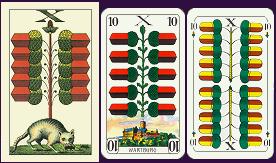A particular detail of the
Württembergisches Bild is that the
ober knaves are featured on horseback: these personages clearly sprang from the German
Tarock, but are curiously even more reminiscent of the horses (i.e. the cavaliers) found in Italian and Spanish decks, which share their same rank.
With the exception of the aforesaid
Württembergisches Bild, in all German-suited patterns the 10s are marked with an X (roman numeral), placed in a central position above the main illustration.
In early decks of the 15th-16th century made in this country, the subject worth 10 used to feature a flag (as Swiss cards still do); having survived, although only as a faint trace, this distinctive detail seems to suggest that many centuries earlier, in early German card games the 10s might have had a special importance.

10s from the single-headed Sächsisches Bild,
Preussisches Bild and Fränkisches Bild |

Fränkisches Bild (by A.S.S., Germany) |
The cards from Bavaria ( Bayerisches Bild) are the ones most closely connected to the ancestor of all present southern patterns, the Altbayerisches Bild, mentioned in page 1. They maintained many specific details of the early illustrations, and were the latest to change scheme from single-headed to double-headed. They are used in the whole south-east of the country, and are probably the German-suited pattern produced by the largest number of manufacturers. They even developed two varieties, which differ by a number of details, and are labelled as the Stralsund type and the München type, after the hometowns of the manufacturers Spielkartenfabrik Altenburg and F.X.Schmid, respectively (the former located in the far north, the latter in the south of the country). |

Bayerisches Bild, München variety (by F.X.Schmid, Germany) |
Their main differences are listed in the table below, and are illustrated in the following pictures.
| MÜNCHEN TYPE |
STRALSUND TYPE |
|---|
| two kings are shaven, two wear a moustache; |
all four kings wear beards and moustaches; |
| the Ober knave of Acorns
holds an oval shield bearing a cross, while his sword points either upwards or downwards; |
the Ober knave of Acorns holds a triangular shield bearing a radiant sun (rather stylized in some editions), while his sword points either upwards or downwards; |
| the Unter knave of Acorns looks downwards, pointing his finger in the same direction; |
the Unter knave of Acorns turns his head to the right; |
| in the daus of Acorns, the upper half of the large cask on which
the child is seated is visible; |
in the daus of Acorns, only a corner of the large cask on which
the child is seated is visible; |
| the pips of the 9 and 10 of Hearts are all red. |
the central pips of the 9 and 10 of Hearts are yellow and blue. |

top row: München variety (by F.X.Schmid);
bottom row: Stralsund variety (by ASS) |

Bayerisches Einfachbild, the single-headed version
of the pattern, recently reprinted by S.A. (Coeur brand) |
page 1
Germany - I
page 3
East Germany
page 4
Central Europe
|

top row: München (by F.X.Schmid and Coeur); the third card is from
the pattern called Salzburger in Italy or Einfachbild in Austria,
shown in comparison with the German design;
bottom row: Stralsund (by Berliner, Nurnberger and ASS) |
GLOSSARY
 |
actual translation |
 |
| SPIELKARTEN | | PLAYING CARDS |
|---|
| SPIEL | game | DECK |
|---|
| FARBE | colours | SUITS |
|---|
| EICHEL | | ACORNS |
|---|
| LAUB (GRÜN) (SCHIPPE) | (green) (spades) | LEAVES |
|---|
| SCHELLEN | | BELLS |
|---|
| HERZ (ROT) | (red) | HEARTS |
|---|
| KARO | square | DIAMONDS |
|---|
| KREUZ | cross | CLUBS |
|---|
| PIK | pike | SPADES |
|---|
| DAUS | deuce | ACE (German-suited decks) |
|---|
| AS | | ACE (French-suited decks) |
|---|
| UNTER | below | LOW RANK KNAVE |
|---|
| OBER | over | HIGH RANK KNAVE |
|---|
| BUBE | | JACK |
|---|
| DAME | lady | QUEEN |
|---|
| KÖNIG | | KING |
|---|
OTHER GALLERIES






















or back to

HISTORICAL
NOTES
|

MULTI-LANGUAGE
GLOSSARY |

THE FOOL &
THE JOKER |

INDEX
TABLE |

REGIONAL
GAMES |

PLAYING CARD
LINKS |